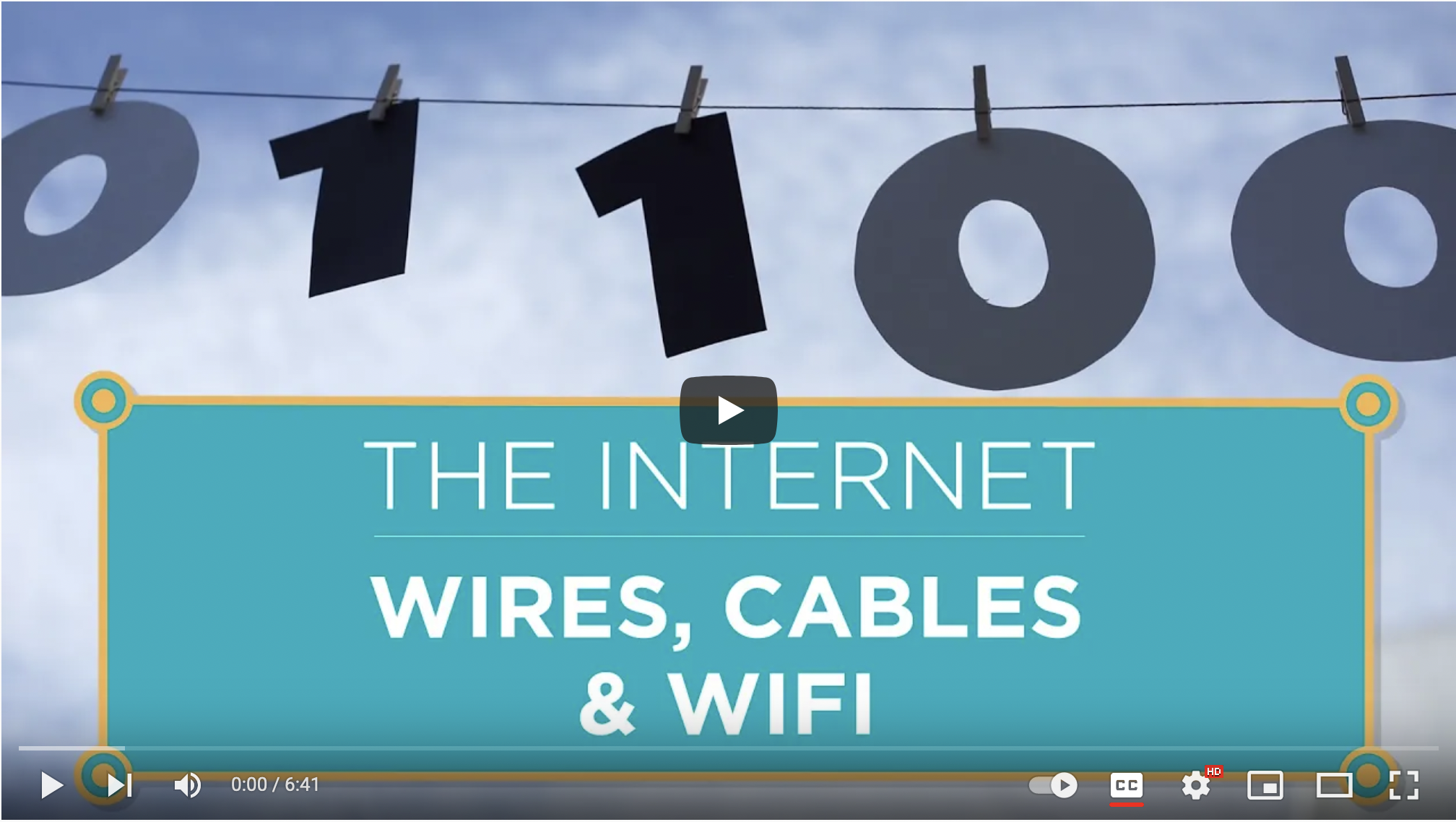2. Wires, cables and Wi-Fi
The Internet is a tangible physical system meant to move information.
It’s like the postal service, except physical. It is sent through binary (base two, 0 or 1) bits.
Bits are a pair of opposites, like being on or off. Typically, they are written as ones and zeros in binary code.
Measuring Data: Bytes
A byte consists of 8 bits, which is the information the Internet ships. No matter what it is (song, video, image, etc.), it's consisted of these bytes. When using larger data, different terms are used, including kilobytes (1,000 bytes), megabytes (1,000 kilobytes) gigabytes (billion bytes), and terrabytes (one million million bytes)
- An mp3 song to equals 3 to 4 MB.
- Everything on the web is bits.
- Bits are like atoms of information.
How we send binary information
The way we send binary information is through the use of physical mediums that make use of electricity, lights and radio waves. We create a system of sending bits from one person to another using electricity. We clock the amount of time bits are used.
Bandwidth refers to the volume of information per unit of time that Internet connection can handle. An internet connection with larger bandwidth can move a video file, for example, much faster than internet connection with lower bandwidth. It is measured in Mbps (bits per second). Larger bandwidth is almost always better, but how much you need depends on what you will be doing. For example, if you have multiple TVs streaming Netflix, larger bandwidth is recommended.
Bit rate
In telecommunications and computing, bit rate (bitrate or as a variable R) is the number of bits that are conveyed or processed per unit of time.[1]
Latency
Latency is the time for one bit to travel from one place to another; any type of delay in network communication low-latency, high-latency
Electricity
Electricity flowing through copper wires is the cheapest form of bit transmission, but signal loss occurs after a few 100 feet copper cable, so powered hubs must be placed at regular intervals.
Copper is far less expensive than fiber optic cable. Copper has the highest electrical conductivity rating of all nonprecious metals. https://en.wikipedia.org/wiki/Copper_conductor
Dialup
Dial up is still being used in 2017: What’s it like to use AOL dial-up internet in 2017? Quote from page: Dial-up isn’t dead. There are many areas in the United States where broadband infrastructure was never put in place, so residents are forced to stick with dial-up. On top of that, there’s a category of users who choose dial-up over broadband to save money. A 2013 report by the Pew Research Center indicated that three percent of Americans were still using a dial-up connection — a small, but significant slice of the population.
Light
Light sends information fast and with no signal loss by sending bits as light beams through fiber optic cables.
Fiber Optic Cable
Fiber Optic Cable is a thread of glass engineered to reflect light. Transferred by bouncing light from one end of the cable to the other
A fiber optic cable consists of a thin glass threads, or fibers, in an insulated casing that allows for faster and longer data transfer and higher bandwidth. They work by shooting pulses of lights from either lasers or LEDs that pass through the cable. They can carry data longer distances than traditional copper cables since light can travel further without losing signal. Fiber Optic Cable
Fiber Optic cable can send multiple bits at same time at speed of light.
When a communications link must span a larger distance than existing fiber-optic technology is capable of, the signal must be regenerated at intermediate points in the link by optical communications repeaters. Repeaters add substantial cost to a communication system, and so system designers attempt to minimize their use.
Recent advances in fiber and optical communications technology have reduced signal degradation so far that regeneration of the optical signal is only needed over distances of hundreds of kilometers. https://en.wikipedia.org/wiki/Fiber-optic_communication
Wireless
Wireless is a very big subject: WiFi, Bluetooth, ZigBee, NFC, WiMax, LTE, HSPA, EV-DO, 3G Satellite and more. Here is a link to a wealth of information about wireless techonology.
radio waves
- send signals from one place to another wirelessly
- translates binary into radio waves of differing frequencies
- receiving machines convert back to binary
- Strength is being wireless; weakness is signal loss after certain distance
Wifi
Wifi has allowed the internet to become mobile and accessed conveniently almost anywhere. Wireless bit-sending machines translate the zeros and ones into radio waves of different frequencies, and then receiving machines translate the radio waves back into binary code. However, wireless internet can only travel up to a certain distance, and still require a physical wire to send data to the router.
Satellite
Requires three satellite dishes. The ISP dish sends a signal to the satellite in space, the satellite dish captures the signal and the user’s dish receives the signal. The user needs a modem and cables from the dish to the computer. The user then sends a request back up to the satellite.
Cons: weather affects the signal. Poor latency (high ping rate). Gaming and VoIP is not feasible. Branches and buildings get in the way. ISP limits bandwidth. VPNs are not compatible. Expensive due to technology and the supply/demand constraints.
Pros: better than dialup. Can get it in very remote areas with no phone lines.
measuring data: binary, bit, byte, kilobyte, megabyte, gigabyte, terrabyte
data throughput and speed: bandwidth, bitrate, latency, requesting device
modes of transmitting data: copper wire, electricity, light, fiber optic cable, thread of glass, bounce angle, radio signal, wireless, signal degradation, wifi, satellite
